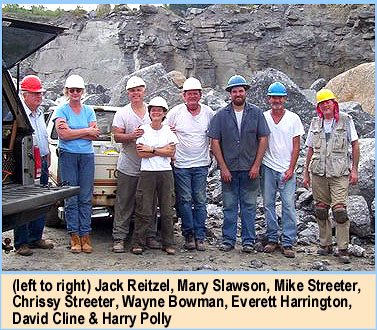
The Crew
(Celia Harrington & Rusty Hill not shown)
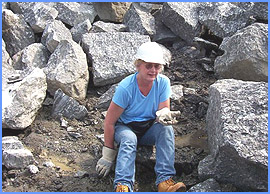
The Hickory Quarry is probably best known for its world-class stilbite crystals, although a wide variety of zeolites and other minerals may be found there. Since the large aggregate quarry is active, conditions continually change there, so that you never know what you may find on any given day. It is important to note that prior arrangements must be made with the mine manager in order to rockhound in the quarry and that simply showing up without notice is strictly prohibited.
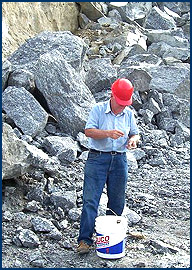
We were fortunate that no trucks or other mining equipment would be running that morning so that we pretty much had the run of the quarry. There was a core hole machine for blasting that was operating on one of the benches and we were cautioned to stay clear of it and the nearby high walls. Vibrations from drilling can cause rocks to slide and fall from the quarry walls. The last thing that any of us would want is for someone to get hurt - not just for an individual's sake but for the potential access problems that such an incident could cause.
Although it is sometimes possible to find a mineral vein on
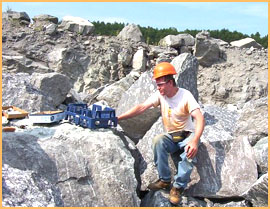 a bench, just about all rockhounding at the Hickory Quarry is confined to the extensive boulder piles. Messing around on or near one of the quarry walls is not generally advisable as the chance for getting whacked by a falling boulder is high. The group fanned out to search for specimens amongst the boulders spread out mostly along the perimeters of the quarry benches.
a bench, just about all rockhounding at the Hickory Quarry is confined to the extensive boulder piles. Messing around on or near one of the quarry walls is not generally advisable as the chance for getting whacked by a falling boulder is high. The group fanned out to search for specimens amongst the boulders spread out mostly along the perimeters of the quarry benches.

Chrissy located a large boulder that contained, on one side, some excellent babingtoninte crystals on a bed of prehnite, calcite, muscovite and other matrix minerals. Since the job of breaking down the rock was too much for her, she called on me to do the necessary busting with my big sledge. Chrissy's excellent ability to find rocks and pockets for me to work has earned her the nickname of "the locator" (pronounced with an Austrian accent like Arnold's). It took well over an hour of heavy duty sledging and chiseling to finally break down the rock to manageable sizes. I was able to recover enough to hand out specimens to most in the group.
Click on specimen pictures to enlarge
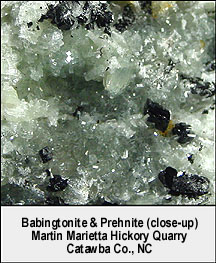
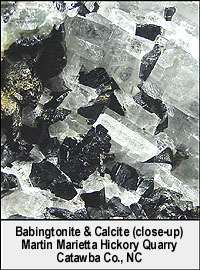
| |
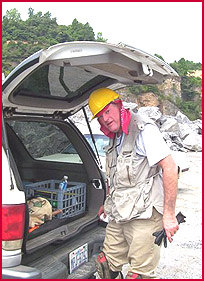
While I was in the middle of breaking down Chrissy's
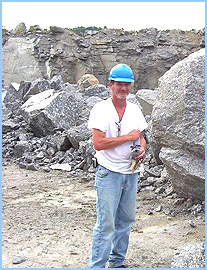 big babingtonite boulder, Everett discovered a vein of fantastic stilbite. He called me over to show it to me and, before long, I was helping him recover the
goodies. It took all of about 1/2-hour to completely exploit the vein, and Everett had many fine stilbite specimens to add to his collection. Everett generously allowed me and others to take a few stibite specimens for ourselves.
big babingtonite boulder, Everett discovered a vein of fantastic stilbite. He called me over to show it to me and, before long, I was helping him recover the
goodies. It took all of about 1/2-hour to completely exploit the vein, and Everett had many fine stilbite specimens to add to his collection. Everett generously allowed me and others to take a few stibite specimens for ourselves.
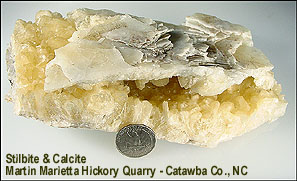 Click on specimen pictures to enlarge
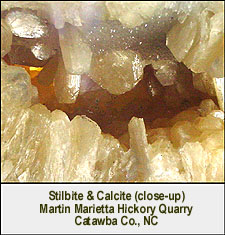
| |
After finishing up with Chrissy's babingtoninte boulder at
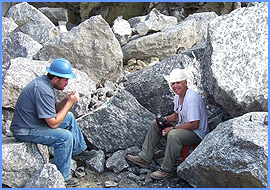 around 10:30 AM, the temperature had climbed into the low 90's and the humidity was stifling. If it got any hotter, I swore that I would start to melt. I managed to find shade next to a massive boulder where Everett joined me for a water break. After about 10 minutes, I felt good enough to get back in the game. About then, I looked up from the back of our truck to see Chrissy staggering toward me carrying her bucket of tools and a large rock. I walked out to meet her and relieved her of a heavy specimen that contained euhedral muscovite in ankerite. She had also found an excellent prehnite and babingtonite specimen.
around 10:30 AM, the temperature had climbed into the low 90's and the humidity was stifling. If it got any hotter, I swore that I would start to melt. I managed to find shade next to a massive boulder where Everett joined me for a water break. After about 10 minutes, I felt good enough to get back in the game. About then, I looked up from the back of our truck to see Chrissy staggering toward me carrying her bucket of tools and a large rock. I walked out to meet her and relieved her of a heavy specimen that contained euhedral muscovite in ankerite. She had also found an excellent prehnite and babingtonite specimen.
Click on specimen pictures to enlarge